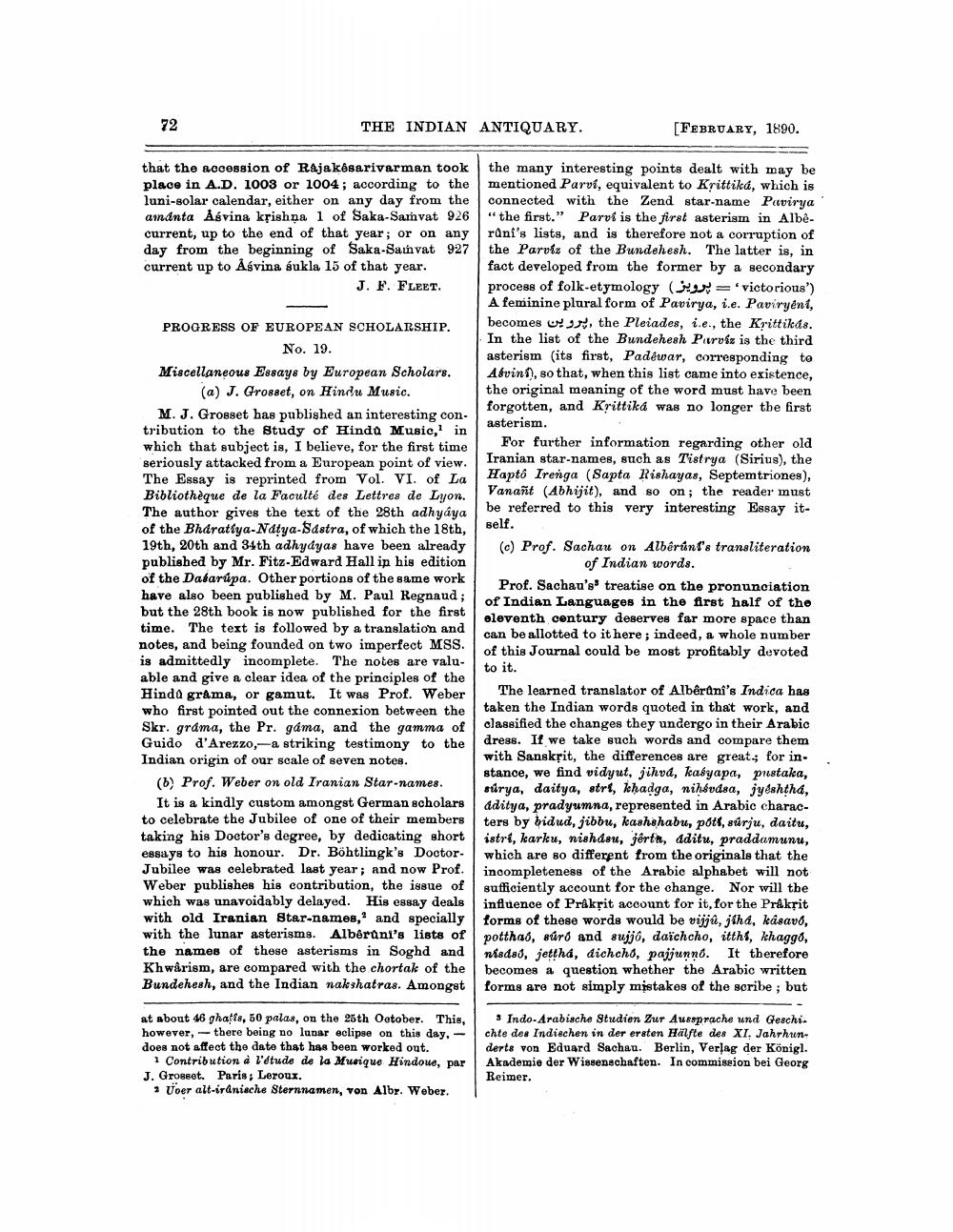________________
72
THE INDIAN ANTIQUARY.
[FEBRUARY, 1890.
that the accession of Raja kősarivarman took place in A.D. 1003 or 1004; according to the luni-solar calendar, either on any day from the amanta Asvina krishna 1 of Saka-Samvat 926 current, up to the end of that year, or on any day from the beginning of Saka-Sathvat 927 current up to Asvina sukla 15 of that year.
J. F. FLEET.
PROGRESS OF EUROPEAN SCHOLARSHIP.
No. 19. Miscellaneous Essays by European Scholars.
(a) J. Grosset, on Hindu Music. M. J. Grosset has published an interesting con. tribution to the Study of Hinda Music, in which that subject is, I believe, for the first time seriously attacked from a European point of view. The Essay is reprinted from Vol. VI. of La Bibliothèque de la Faculté des Lettres de Lyon. The author gives the text of the 28th adhyaya of the Bharatiya-Natya-Sastra, of which the 18th, 19th, 20th and 34th adhydyas have been already published by Mr. Fitz-Edward Hall in his edition of the Dabarúpa. Other portions of the same work have also been published by M. Paul Regnaud; but the 28th book is now published for the first time. The text is followed by a translation and notes, and being founded on two imperfect MSS. is admittedly incomplete. The notes are valuable and give a clear idea of the principles of the Hinda grama, or gamut. It was Prof. Weber who first pointed out the connexion between the Skr. grama, the Pr. gáma, and the gamma of Guido d'Arezzo,-a striking testimony to the Indian origin of our scale of seven notes.
(6) Prof. Weber on old Iranian Star-names.
It is a kindly custom amongst German scholars to celebrate the Jubilee of one of their members taking his Doctor's degree, by dedicating short essays to his honour. Dr. Böhtlingk's DoctorJubilee was celebrated last year; and now Prof. Weber publishes his contribution, the issue of which was unavoidably delayed. His essay deals with old Iranian Star-names, and specially with the lunar asterisms. Albêruni's lists of the names of these asterisms in Soghd and Khwârism, are compared with the chortak of the Bundehesh, and the Indian nakshatras. Amongst
the many interesting points dealt with may be mentioned Parvi, equivalent to Krittikd, which is connected with the Zend star-name Pavirya " the first." Parvi is the first asterism in Alberuni's lists, and is therefore not a corruption of the Parvix of the Bundehesh. The latter is, in fact developed from the former by a secondary process of folk-etymology (
victorious") A feminine plural form of Pavirya, i.e. Paviryent, becomes w , the Pleiades, i.e., the Krittikds. In the list of the Bundehesh Parvix is the third asterism (its first, Paddwar, corresponding to Atvin), so that, when this list came into existence, the original meaning of the word must have been forgotten, and Krittiká was no longer the first asterism.
For further information regarding other old Iranian star-names, such as Tistrya (Sirius), the Haptó Irenga (Sapta Rishayas, Septemtriones), Vanañt (Abhijit), and so on; the reader must be referred to this very interesting Essay itself. (c) Prof. Sachar on Albêrúnt's transliteration
of Indian words. Prof. Sachau's' treatise on the pronunciation of Indian Languages in the first half of the eleventh century deserves far more space than can be allotted to it here ; indeed, a whole number of this Journal could be most profitably devoted to it.
The learned translator of Albêrani's Indica has taken the Indian words quoted in that work, and classified the changes they undergo in their Arabic dress. If we take such words and compare them with Sanskrit, the differences are great for in. stance, we find vidyut, jihvd, kalyapa, pustaka, súrya, daitya, strt, khadga, nihávdsa, jyéshtha, dditya, pradyumna, represented in Arabic characters by bidud, jibbu, kashshabu, poti, súrju, daitu, istri, karku, nishdsu, jêrth, aditu, praddamunu, which are so different from the originale that the incompleteness of the Arabic alphabet will not sufficiently account for the change. Nor will the influence of Pråkpit account for it, for the Praksit forms of these words would be vijju, jiha, käsavo, potthað, súró and sujjó, daïchcho, itthí, khaggo, misdad. jettha, dichcho, pajjunno. It therefore becomes a question whether the Arabic written forms are not simply mistakes of the scribe ; but
at about 46 ghatis, 50 palas, on the 25th October. This, however, there being no lunar eclipse on this day, - does not affect the date that has been worked out.
1 Contribution à l'étude de la Musique Hindoue, par J. Grosset. Paris : Leroux. * Voer alt-iranische Sternnamen, von Albr. Weber.
3 Indo-Arabische Studien Zur Aussprache und Geschi. chte des Indiechen in der ersten Hälfte des XI. Jahrhunderts von Eduard Sachau. Berlin, Verlag der Königl. Akademie der Wissenschaften. In commission bei Georg Reimer.




